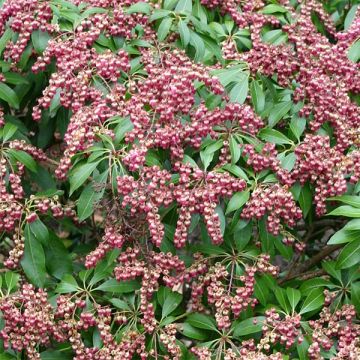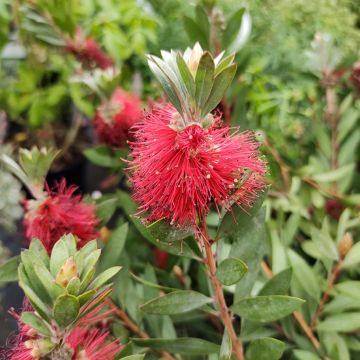

Pieris japonica Bonfire - Japanese Andromeda


Pieris japonica Bonfire - Japanese Andromeda
Pieris japonica Bonfire - Japanese Andromeda
Pieris japonica Bonfire
Japanese Andromeda, Japanese Pieris, Lily-of-the-Valley Bush
This item cannot be shipped to the selected country
Delivery charge from €5.90
Delivery charge from €5.90
More information
Schedule delivery date,
and select date in basket
This plant carries a 24 months recovery warranty
More information
We guarantee the quality of our plants for a full growing cycle, and will replace at our expense any plant that fails to recover under normal climatic and planting conditions.
From €5.90 for pickup delivery and €6.90 for home delivery
Express home delivery from €8.90.
From €5.90 for pickup delivery and €6.90 for home delivery
Express home delivery from €8.90.

Does this plant fit my garden?
Set up your Plantfit profile →
Description
Pieris japonica 'Bonfire' is a variety of small size, making it perfect for small spaces and ornamenting a container on a terrace. This shrub of non-calcareous soil is interesting for the salmon colour of its young satin leaves which turn green when mature. In spring, it bears abundant clusters of beautiful creamy white flowers. By illuminating the semi-shaded areas of the garden or terrace, this bush offers a charming and colourful spectacle throughout the year!
Pieris japonica, commonly called Japanese Andromeda, is native to eastern China, Japan, and Taiwan. It belongs to the Ericaceae family, and is a cousin of heathers and camellias with which it forms very beautiful masses. The cultivar 'Bonfire' has a compact and rounded habit. Its growth is rather slow; it ultimately forms a shrub measuring about 1 m (3.3 ft) in all directions. It has beautiful evergreen foliage in winter, composed of long shiny, lanceolate and pointed leaves, slightly dentate on the edges, measuring up to 10 cm (3.9 in) long. The young shoots are orange to coppery pink, then the leaves become light green, and finally dark green. The clusters of dark pink flower buds appear in winter, reinforcing the decorative effect of this Japanese Andromeda in the dull season. In April, it is covered with a multitude of upright clusters, 10 cm to 15 cm (3.9 in to 5.9 in) long, composed of small urn-shaped flowers, ranging from pale pink to creamy white, reminiscent of lily-of-the-valley flowers. The flowers exude a sweet honey fragrance.
Pieris japonica are shrubs with good hardiness, appreciating acidic and moist soils, as well as semi-shaded exposure. Due to its low development and extremely decorative aspect throughout the seasons, 'Bonfire' is perfectly suited for container gardening, on a semi-shaded terrace, patio or balcony. It will also find its place under the cover of large trees, with partially shaded shrubs, as a low hedge, in a shaded rock garden, and especially within an ericaceous bed, in the company of plants such as Camellias, Rhododendrons, heathers, Azalea mollis, or Azalea japonica. With its generous flowering, it will make an impression when combined with spring bulbs (daffodils, early tulips), hellebores, and primroses. It has its rightful place in a Japanese-style garden!
Report an error about the product description
Pieris japonica Bonfire - Japanese Andromeda in pictures




Plant habit
Flowering
Foliage
Botanical data
Pieris
japonica
Bonfire
Ericaceae
Japanese Andromeda, Japanese Pieris, Lily-of-the-Valley Bush
Cultivar or hybrid
Other Pieris
Planting and care
'Bonfire' enjoys a semi-shaded exposure or gentle sunlight, as well as an acidic, moist, light, humus-rich, and well-drained soil. With good hardiness, it can withstand temperatures as low as -15° C (5° F) in perfectly drained soil, but its young shoots can be damaged by late frosts. It is advisable to plant it in a sheltered location protected from cold and drying winter winds. Install a thick mulch at its base in autumn, in harsh climates or in situations exposed to winter winds. A thick layer of fern fronds, dead leaves, and pine needles would be ideal. If its young foliage has been damaged by frost, it should be pruned to stimulate the growth of new shoots. Appreciating good humidity, it prefers constantly moist soil but not the stagnant moisture of clay soils. To prevent soil drying out, regular watering with non-limestone water is necessary, especially in the first year after planting and during the summer period. Plant in spring or autumn, in a mixture of garden soil, turf, and ericaceous soil. In spring, it is advisable to surface-dress with ericaceous soil and compost around its roots and possibly apply a basal fertiliser in the form of a handful of dried blood. Take care to provide enough space to ensure its proper development, respecting a planting distance of 0.70 cm to 1 m (0.3 in to 3.3 ft) around its base. After flowering, remove faded flowers to avoid unnecessarily exhausting the plant by seed production. Also, lightly prune sparse branches that compromise its bushy habit.
Planting period
Intended location
Care
This item has not been reviewed yet - be the first to leave a review about it.
Evergreen shrubs
Haven't found what you were looking for?
Hardiness is the lowest winter temperature a plant can endure without suffering serious damage or even dying. However, hardiness is affected by location (a sheltered area, such as a patio), protection (winter cover) and soil type (hardiness is improved by well-drained soil).

Photo Sharing Terms & Conditions
In order to encourage gardeners to interact and share their experiences, Promesse de fleurs offers various media enabling content to be uploaded onto its Site - in particular via the ‘Photo sharing’ module.
The User agrees to refrain from:
- Posting any content that is illegal, prejudicial, insulting, racist, inciteful to hatred, revisionist, contrary to public decency, that infringes on privacy or on the privacy rights of third parties, in particular the publicity rights of persons and goods, intellectual property rights, or the right to privacy.
- Submitting content on behalf of a third party;
- Impersonate the identity of a third party and/or publish any personal information about a third party;
In general, the User undertakes to refrain from any unethical behaviour.
All Content (in particular text, comments, files, images, photos, videos, creative works, etc.), which may be subject to property or intellectual property rights, image or other private rights, shall remain the property of the User, subject to the limited rights granted by the terms of the licence granted by Promesse de fleurs as stated below. Users are at liberty to publish or not to publish such Content on the Site, notably via the ‘Photo Sharing’ facility, and accept that this Content shall be made public and freely accessible, notably on the Internet.
Users further acknowledge, undertake to have ,and guarantee that they hold all necessary rights and permissions to publish such material on the Site, in particular with regard to the legislation in force pertaining to any privacy, property, intellectual property, image, or contractual rights, or rights of any other nature. By publishing such Content on the Site, Users acknowledge accepting full liability as publishers of the Content within the meaning of the law, and grant Promesse de fleurs, free of charge, an inclusive, worldwide licence for the said Content for the entire duration of its publication, including all reproduction, representation, up/downloading, displaying, performing, transmission, and storage rights.
Users also grant permission for their name to be linked to the Content and accept that this link may not always be made available.
By engaging in posting material, Users consent to their Content becoming automatically accessible on the Internet, in particular on other sites and/or blogs and/or web pages of the Promesse de fleurs site, including in particular social pages and the Promesse de fleurs catalogue.
Users may secure the removal of entrusted content free of charge by issuing a simple request via our contact form.
The flowering period indicated on our website applies to countries and regions located in USDA zone 8 (France, the United Kingdom, Ireland, the Netherlands, etc.)
It will vary according to where you live:
- In zones 9 to 10 (Italy, Spain, Greece, etc.), flowering will occur about 2 to 4 weeks earlier.
- In zones 6 to 7 (Germany, Poland, Slovenia, and lower mountainous regions), flowering will be delayed by 2 to 3 weeks.
- In zone 5 (Central Europe, Scandinavia), blooming will be delayed by 3 to 5 weeks.
In temperate climates, pruning of spring-flowering shrubs (forsythia, spireas, etc.) should be done just after flowering.
Pruning of summer-flowering shrubs (Indian Lilac, Perovskia, etc.) can be done in winter or spring.
In cold regions as well as with frost-sensitive plants, avoid pruning too early when severe frosts may still occur.
The planting period indicated on our website applies to countries and regions located in USDA zone 8 (France, United Kingdom, Ireland, Netherlands).
It will vary according to where you live:
- In Mediterranean zones (Marseille, Madrid, Milan, etc.), autumn and winter are the best planting periods.
- In continental zones (Strasbourg, Munich, Vienna, etc.), delay planting by 2 to 3 weeks in spring and bring it forward by 2 to 4 weeks in autumn.
- In mountainous regions (the Alps, Pyrenees, Carpathians, etc.), it is best to plant in late spring (May-June) or late summer (August-September).
The harvesting period indicated on our website applies to countries and regions in USDA zone 8 (France, England, Ireland, the Netherlands).
In colder areas (Scandinavia, Poland, Austria...) fruit and vegetable harvests are likely to be delayed by 3-4 weeks.
In warmer areas (Italy, Spain, Greece, etc.), harvesting will probably take place earlier, depending on weather conditions.
The sowing periods indicated on our website apply to countries and regions within USDA Zone 8 (France, UK, Ireland, Netherlands).
In colder areas (Scandinavia, Poland, Austria...), delay any outdoor sowing by 3-4 weeks, or sow under glass.
In warmer climes (Italy, Spain, Greece, etc.), bring outdoor sowing forward by a few weeks.























































